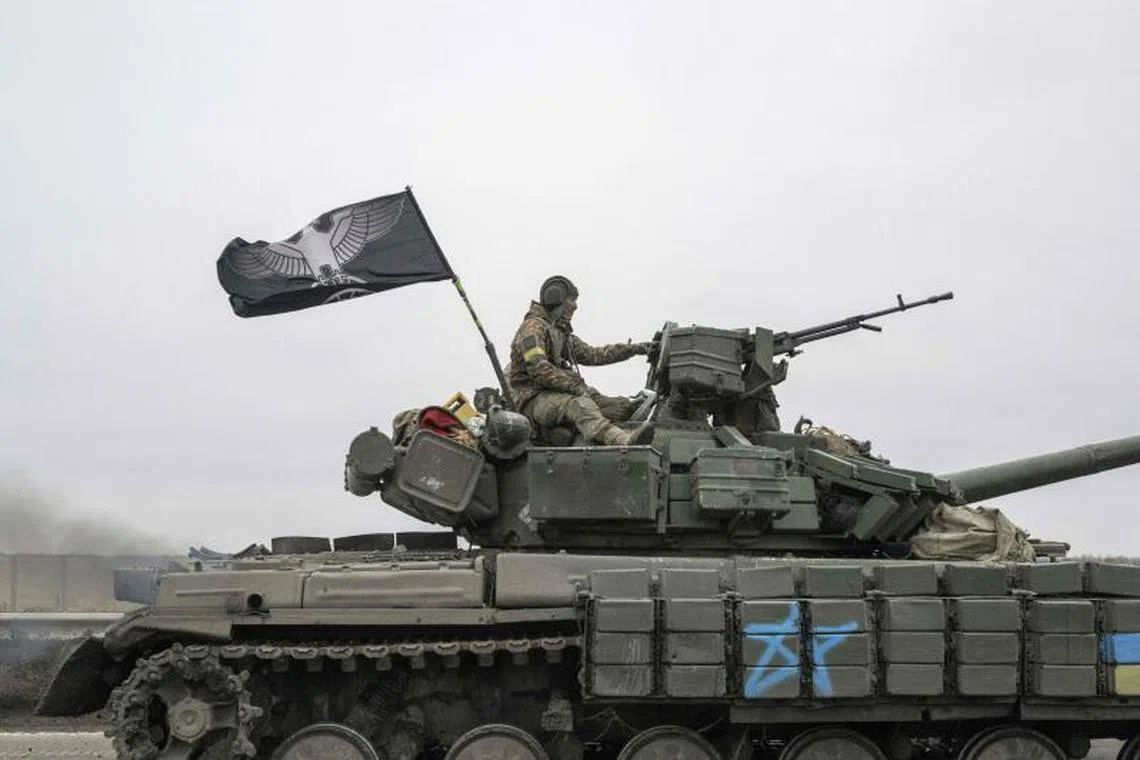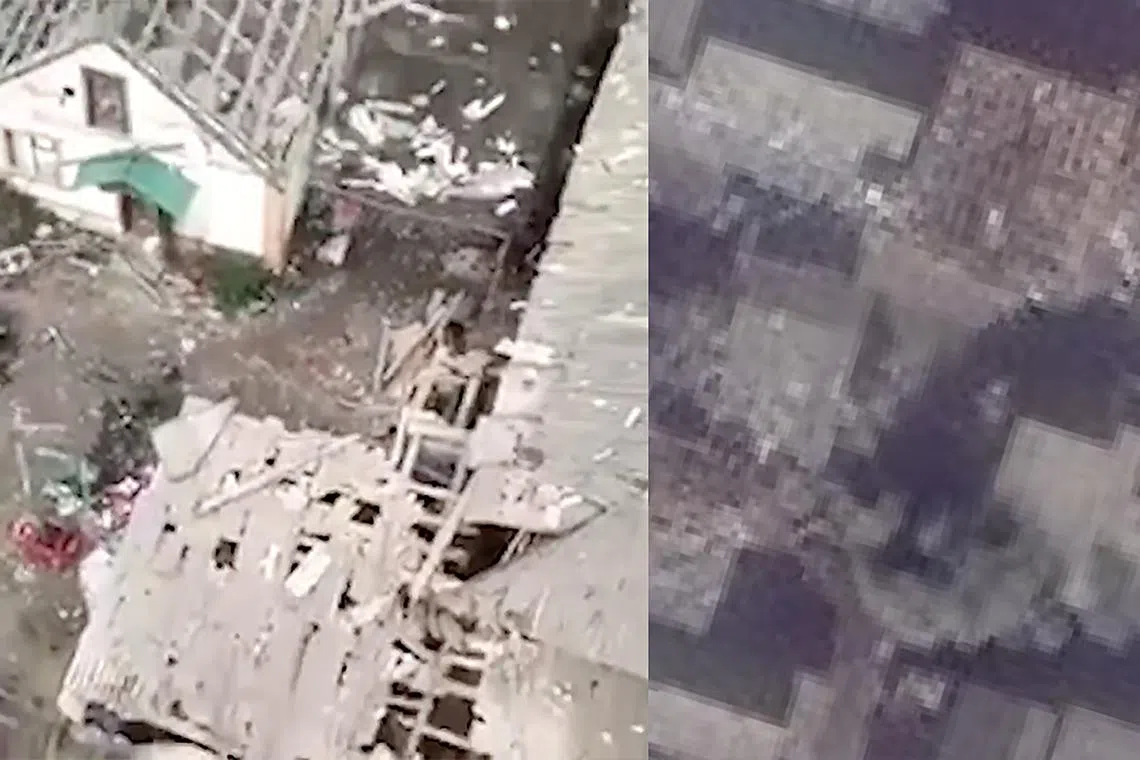Videos suggest captive Russian soldiers were killed at close range
Sign up now: Get ST's newsletters delivered to your inbox

Russian and Ukrainian forces have both been accused of war crimes.
PHOTO: AFP
Follow topic:
KYIV – A series of videos that surfaced on social media last week has ignited a debate over whether Ukrainian forces committed war crimes or acted in self-defence as they tried to capture a group of Russian soldiers who were then killed.
The videos show the grisly before-and-after scenes of the encounter earlier in November, in which at least 11 Russians, most of whom are seen lying on the ground, appear to have been shot dead at close range after one of their fellow fighters suddenly opened fire on Ukrainian soldiers standing nearby.
The videos, whose authenticity has been verified by The New York Times, offer a rare look into one gruesome moment among many in the war, but do not show how or why the Russian soldiers were killed. Ultimately, they leave a mystery that has been used by both sides in the online battle for hearts and minds.
The videos were first circulated by Ukrainian news and social media channels that used them to laud the military prowess of their armed forces and publicise their heroic retaking of territory lost to Russia early in the war. In Russia, however, the videos prompted a fierce response among hawkish pro-war commentators, who urged the government to seek an international investigation.
Now, Moscow and Kyiv has each accused the other of committing war crimes in the same episode – the Russians accusing Ukraine’s forces of “mercilessly shooting unarmed Russian POWs”, and Ukraine’s commissioner for human rights, Mr Dmytro Lubinets, saying Russian soldiers had opened fire during the act of surrendering.
Russian and Ukrainian forces have both been accused of war crimes since Moscow ordered a full-scale invasion of Ukraine in late February,
The United Nations has said the episode should be investigated.
“We are aware of the videos, and we are looking into them,” Ms Marta Hurtado, a spokesperson for the UN Human Rights Office, told Reuters on Friday. “Allegations of summary executions of people hors de combat should be promptly, fully and effectively investigated, and any perpetrators held to account.”
Under international law, the French term “hors de combat” refers to people who are “outside of combat” because of their surrender, being unarmed, unconscious or otherwise unable to defend themselves.
Video diary
The killings occurred as the Ukrainian army recaptured the village of Makiivka, in the Luhansk region, in mid-November, when Russian forces suffered heavy losses.
By comparing the videos to satellite imagery, the Times confirmed that the videos were filmed at a farmhouse in the village.
The first video is set to music – a feature commonly used in social media video diaries – and shows a group of armed Ukrainian soldiers lying in a field as they fire on a target in the distance. The soldiers sound Ukrainian, and speak both Ukrainian and Russian.
Gunshots are heard, and the cameraman shows his face.
The second video gives an aerial perspective of the same group of Ukrainian soldiers inside the courtyard of a farmhouse. The house and surrounding buildings are badly damaged by fighting, as many other buildings in the area were.
It shows a Ukrainian soldier lying on the ground in a prone position, aiming a belt-fed machine gun at one of the sheds in the complex. A second Ukrainian soldier is standing behind him. A third Ukrainian soldier is pacing around the courtyard holding a rifle, and a fourth is on the ground checking the body of what appears to be a dead Russian soldier. A second body, also apparently Russian, lies motionless nearby.

Satellite imagery of Makiivka village, in Luhansk, Ukraine.
PHOTO: NYTIMES
More Russian soldiers are sheltering inside one of the sheds, but we don’t see them yet.
The next scene is a cellphone video filmed in the courtyard by the same Ukrainian soldier. There are gaps in the video, although it’s unclear why. It shows the four Ukrainian soldiers, at least three of whom are armed.
One soldier, with his rifle drawn, tentatively approaches the structure where the Russian soldiers are sheltering. The soldier with the machine gun provides cover. Several gunshots are heard – although it’s not clear from where – and the soldier slowly backs away from an outhouse, drawing out the Russian soldiers at gunpoint.
The video cuts off, and when it restarts, six Russian soldiers are lying facedown on the ground beside one another. At least two of them are alive and can be seen moving in the video; the others are motionless. The video shows four other soldiers slowly exiting the outhouse, one after the other, some with their arms raised. They join the other soldiers on the ground.
The Russians are wearing flak jackets and helmets, and their uniforms bear distinctive markings – red straps on their lower legs, one with a square blue object on his back.
Two of the Ukrainians standing by appear to be relaxed and are pointing their rifles toward the ground. The capture of these soldiers is initially orderly and without incident – but suddenly everything changes.
As an 11th Russian soldier emerges from the outhouse, he opens fire, aiming at one of the Ukrainian soldiers. The Ukrainians are taken by surprise. The cellphone camera jolts away as the Ukrainian soldier filming the scene flinches. A frame-by-frame analysis of what happens next shows the Ukrainian soldier standing beside him raise his rifle and aim toward the Russian gunman.
The video ends and it’s unclear what happens next. But a second aerial video of the location shows the bloody aftermath.
The Russian soldiers are lying motionless, apparently dead, most of them positioned as they were when they surrendered. Blood is pooling around them, and some appear to be bleeding from the upper body or head. The soldiers are dressed in the same uniforms with the distinctive red straps and blue marking.
The Russian soldier who fired at the Ukrainians appears to have been killed on the spot, and he is lying in the position from where he opened fire. The white brick wall beside where he had stood is freshly damaged, perhaps by Ukrainian forces’ returning fire.
Self-defence or summary execution?
“It looks like most of them were shot in the head,” Dr Rohini Haar, medical adviser at Physicians for Human Rights, said in an interview. “There are pools of blood. That indicates that they were just left there dead. There appears to have been no effort to pick them up or help them.”
Dr Iva Vukusic, a war crimes prosecution expert at Utrecht University, said it was difficult to determine whether a war crime had or had not been committed based on the video evidence alone, and that the critical factor was time – when the Russians were shot.
“Was it in one or two bursts of fire at the moment of, or immediately after, the last Russian comes out and shoots at the Ukrainians?” Dr Vukusic said. “Or was it after the immediate threat had been neutralised, as an act of revenge – then this is more clearly a war crime.”
If the Russians were shot in the heat of the moment, Dr Vukusic said, it is not clearly a crime. “If these POWs were not searched yet, then the Ukrainians don’t know if they’re armed, even if they are on the ground.”
The Russian gunman’s actions are critical, too, Dr Vukusic said, and could be deemed perfidy – feigning surrender or noncombatant status as a ruse against the Ukrainians – which may be prosecutable as a war crime under the Geneva Conventions.
“It may very well be that, had this guy not fired, that they all would have been captured as POWs, and survived,” Dr Vukusic added.
Both sides have blood on their hands
UN investigators said in October that they had documented cases of Russian forces torturing civilian and military prisoners. The investigators also found that Ukrainian troops had tortured and abused prisoners of war, but “on a lesser scale”.
The Times has reported on multiple cases of alleged Russian war crimes, including the use of banned weapons, attacks on civilian targets and the killing of noncombatants. In March, a visual investigation by the Times showed Russian troops executing a group of captive Ukrainian fighters and a civilian in Bucha, a suburb west of Kyiv. The Times also reported on the alleged execution of Russian captives by Ukrainian forces in April. by Ukrainian forces in April.
The videos from Makiivka caused an outrage among Russian pro-war commentators.
Mr Vladlen Tatarsky, a popular activist and blogger, said in a post on the Telegram social messaging app that every Russian “must watch this several times to understand whom we are fighting against”, and that “not a single Russian can live and sleep calmly” as long as the perpetrators are alive.
Russia’s human rights council said it would send the video to international organisations. The country’s investigative committee, Russia’s equivalent of the FBI, opened a criminal investigation into the encounter. NYTIMES

